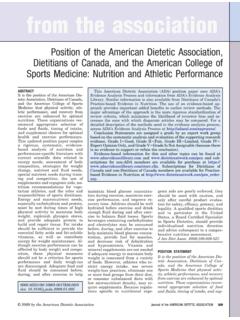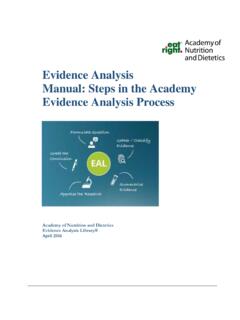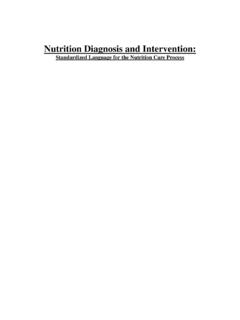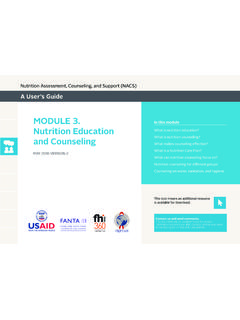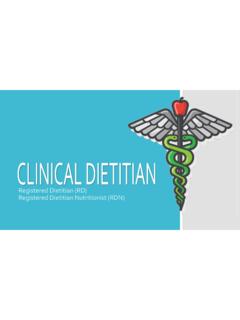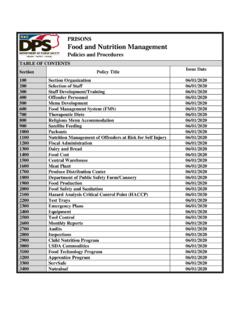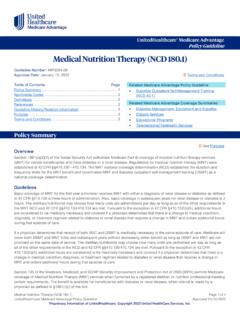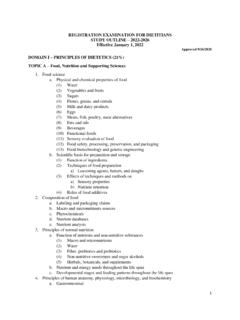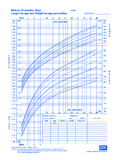Transcription of Nutrition Diagnosis - EAL
1 Nutrition Diagnosis : A Critical Step in the Nutrition Care Process Nutrition Diagnosis : A Critical Step in the Nutrition Care Process ISBN: 0-88091-358-4 Copyright 2006, American Dietetic Association. All rights reserved. No part of this publication may be reproduced, stored in a retrieval system, or transmitted in any form or by any means without the prior written consent of the publisher. Printed in the United States of America. The views expressed in this publication are those of the authors and do not necessarily reflect policies and/or official positions of the American Dietetic Association. Mention of product names in this publication does not constitute endorsement by the authors or the American Dietetic Association. The American Dietetic Association disclaims responsibility for the application of the information contained herein. 10 9 8 7 6 5 4 3 2 1 Nutrition Diagnosis : A Critical Step in the Nutrition Care ProcessTable of Contents Section I: The Nutrition Care Process Nutrition Care Process and Model II: Development of Standardized LanguageAmerican Dietetic Association s Standardized Language Model: Current III: Introduction to Nutrition Diagnosis Introduction to Nutrition IV: Nutrition Diagnosis Reference Sheets Single Page List of Nutrition Diagnostic V: Nutrition Diagnosis Terms and DefinitionsNutrition Terms and VI.
2 Appendix Procedure for NutritionControlled Vocabulary/Terminology Maintenance/Review154 Acknowledgements Task Force Research Reference on Implementation of Nutrition Care Ready Pocket check the ADA Web site for additional Sign in as a member and select Research from sidebar. Sign in as a member and select Quality Management and Outcomesfrom the sidebar. iiiNutrition Care Process and Model: ADA adopts roadmap to quality care and outcomes managementKAREN LACEY, MS, RD; ELLEN PRITCHETT, RDThe establishment and implementation of a standardizedNutrition Care Process (NCP) and Model were identified aspriority actions for the profession for meeting goals of theADA Strategic Plan to Increase demand and utilization of ser-vices provided by members and Empower members to com-pete successfully in a rapidly changing environment (1).
3 Pro-viding high-quality Nutrition care means doing the right thing atthe right time, in the right way, for the right person, and achiev-ing the best possible results. Quality improvement literatureshows that, when a standardized process is implemented, lessvariation and more predictability in terms of outcomes occur(2). When providers of care, no matter their location, use aprocess consistently, comparable outcomes data can be gener-ated to demonstrate value. A standardized Nutrition Care Pro-cess effectively promotes the dietetics professional as theunique provider of Nutrition care when it is consistently used asa systematic method to think critically and make decisions toprovide safe and effective Nutrition care (3).This article describes the four steps of ADA s Nutrition CareProcess and the overarching framework of the Nutrition CareModel that illustrates the context within which the NutritionCare Process occurs.
4 In addition, this article provides the ratio-nale for a standardized process by which Nutrition care is pro-vided, distinguishes between the Nutrition Care Process andMedical Nutrition Therapy (MNT), and discusses future impli-cations for the to the adoption of this standardized Nutrition Care Pro-cess, a variety of Nutrition care processes were utilized by prac-titioners and taught by dietetics educators. Other allied healthprofessionals, including nursing, physical therapy, and occupa-tional therapy, utilize defined care processes specific to theirprofession (4-6). When asked whether ADA should develop astandardized Nutrition Care Process, dietetics professionalswere overwhelmingly in favor and strongly supportive of havinga standardized Nutrition Care Process for use by registereddietitians (RD) and dietetics technicians, registered (DTR).The Quality Management Committee of the House of Dele-gates (HOD) appointed a Nutrition Care Model Workgroup inMay 2002 to develop a Nutrition care process and model.
5 Thefirst draft was presented to the HOD for member input andreview in September 2002. Further discussion occurred duringthe October 2002 HOD meeting, in Philadelphia. Revisionswere made accordingly, and the HOD unanimously adopted thefinal version of the Nutrition Care Process and Model on March31, 2003 for implementation and dissemination to the dieteticsprofession and the Association for the enhancement of thepractice of dietetics. SETTING THE STAGED efinition of Quality/Rationale for a StandardizedProcessThe National Academy of Science s (NAS) Institute of Medi-cine (IOM) has defined quality as The degree to which healthservices for individuals and populations increase the likelihoodof desired health outcomes and are consistent with currentprofessional knowledge (7,8). The quality performance of pro-viders can be assessed by measuring the following: (a) theirpatients outcomes (end-results) or (b) the degree to whichproviders adhere to an accepted care process (7,8).
6 The Com-mittee on Quality of Health Care in America further states thatit is not acceptable to have a wide quality chasm, or a gap,betweenactualandbest possibleperformance (9). In an effortto ensure that dietetics professionals can meet both require-ments for quality performance noted above, the American Di-etetic Association (ADA) supports a standardized NutritionCare Process for the Process versus Standardized CareADA s Nutrition Care Process is a standardized process fordietetics professionals and not a means to provide standardizedcare. A standardized process refers to a consistent structureand framework used to provide Nutrition care, whereas stan-K. Lacey is lecturer and Director of Dietetic Programsat the University of Wisconsin-Green Bay, Green Bay. Sheis also the Chair of the Quality Management Pritchett is Director, Quality and Outcomes at ADAheadquarters in Chicago, you have questions regarding the Nutrition Care Pro-cess and Model, please contact Ellen Pritchett, RD, CPHQ,Director of Quality and Outcomes at 2003 by the American Dietetic $ : PROFESSIONAL INTERESTJ ournal of THE AMERICAN DIETETIC ASSOCIATION /1061 Edition: 20061dardized care infers that all patients/clients receive the samecare.
7 This process supports and promotes individualized care,not standardized care. As represented in the model (Figure 1),the relationship between the patient/client/group and dieteticsprofessional is at the core of the Nutrition care process. There-fore, Nutrition care provided by qualified dietetics profession-als should always reflect both the state of the science and thestate of the art of dietetics practice to meet the individualizedneeds of each patient/client/group (10).Using the NCPEven though ADA s Nutrition Care Process will primarily beused to provide Nutrition care to individuals in health care set-tings (inpatient, ambulatory, and extended care), the processalso has applicability in a wide variety of community settings. Itwill be used by dietetics professionals to provide Nutrition careto both individuals and groups in community-based agenciesand programs for the purpose of health promotion and diseaseprevention (11,12).
8 Key TermsTo lay the groundwork and facilitate a clear definition of ADA sNutrition Care Process, key terms were developed. These def-initions provide a frame of reference for the specific compo-nents and their functions.(a) Process is a series of connected steps or actions toachieve an outcome and/or any activity or set of activities thattransforms inputs to outputs.(b) Process Approach is the systematic identification andmanagement of activities and the interactions between activi-ties. A process approach emphasizes the importance of thefollowing: understanding and meeting requirements; determining if the process adds value; determining process performance and effectiveness; and using objective measurement for continual improvement ofthe process (13).(c) Critical Thinking integrates facts, informed opinions, ac-tive listening and observations. It is also a reasoning process inwhich ideas are produced and evaluated.
9 The Commission onAccreditation of Dietetics education (CADE) defines criticalthinking as transcending the boundaries of formal educationto explore a problem and form a hypothesis and a defensibleconclusion (14). The use of critical thinking provides a uniquestrength that dietetics professionals bring to the Nutrition CareProcess. Further characteristics of critical thinking include theability to do the following: conceptualize; think rationally; think creatively; be inquiring; and think 1. ADA Nutrition Care Process and PROFESSIONAL INTEREST1062/ August 2003 Volume 103 Number 8 Edition: 20062(d) Decision Making is a critical process for choosing the bestaction to meet a desired goal.(e) Problem Solving is the process of the following: problem identification; solution formation; implementation; and evaluation of the results.(f) Collaboration is a process by which several individuals orgroups with shared concerns are united to address an identifiedproblem or need, leading to the accomplishment of what eachcould not do separately (15).
10 DEFINITION OF ADA S NCPU sing the terms and concepts described above, ADA s Nutri-tion Care Process is defined as a systematic problem-solvingmethod that dietetics professionals use to critically think andmake decisions to address Nutrition related problems and pro-vide safe and effective quality Nutrition care. The Nutrition Care Process consists of four distinct, but in-terrelated and connected steps: (a) Nutrition Assessment, (b) Nutrition Diagnosis , (c) Nutrition Intervention, and d) Nutri-tion Monitoring and Evaluation. These four steps were finalizedbased on extensive review and evaluation of previous worksdescribing Nutrition care (16-24). Even though each stepbuilds on the previous one, the process is not linear. Criticalthinking and problem solving will frequently require that die-tetics professionals revisit previous steps to reassess, add, orrevise Nutrition diagnoses; modify intervention strategies;and/or evaluate additional outcomes.




